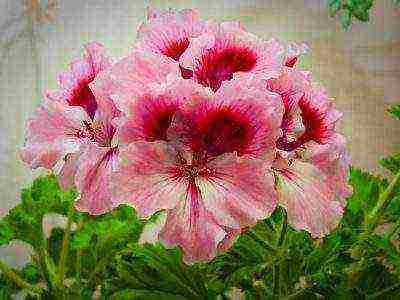Content
- 1 general characteristics
- 2 "Kishmish Radiant": features of the variety (video)
- 3 Breeding features
- 4 Grapes: variety selection (video)
- 5 Reviews and comments
- 6 Raisins from raisins
- 7 Where did the bones go
- 8 Groups and varieties of seedless grapes
- 9 Classification of seedless grapes
- 10 "Arsenyevsky"
- 11 "Kesha"
- 12 "White Flame"
- 13 "Radiant"
- 14 "Black"
- 15 "Black Sultan"
- 16 "Red nutmeg"
- 17 "Black Cinnamon"
- 18 "Russian korinka"
 There are many seedless grape varieties, or so-called seedless varieties. Such grapes are used most often for fresh consumption, but some varieties are suitable for drying. Among all varieties, seedless raisins are especially loved by winegrowers and consumers. It is this grape that is recognized as the leader in its category.
There are many seedless grape varieties, or so-called seedless varieties. Such grapes are used most often for fresh consumption, but some varieties are suitable for drying. Among all varieties, seedless raisins are especially loved by winegrowers and consumers. It is this grape that is recognized as the leader in its category.
general characteristics
Almost all seedless grape varieties were obtained as a result of breeding work. The exceptions are varieties such as "Thompson" and "Black Monucca". A significant part of varieties and hybrid forms are bred as a result of crossing these two varieties.
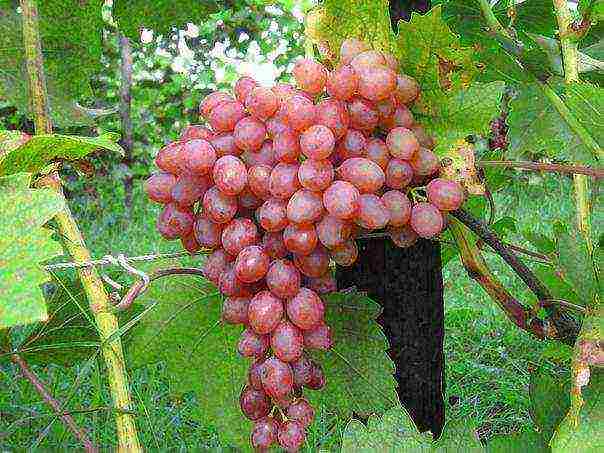
In varieties and hybrid forms obtained over the years, the presence or absence of seed rudiments varies considerably. Many have only traces of small rudimentary seeds. However, in some varieties and hybrids, such traces of grape seeds are quite noticeable. Traces of grape seeds can vary not only in size, but also in terms of hardness, as well as quantity.
Seedless grapes have an optimal ratio of sugars and juice acidity, which gives it a unique, very pleasant taste. In addition, the characteristics of seedless grape varieties include their use as excellent pollinators for other varieties and hybrids of grapes.
"Kishmish Radiant": features of the variety (video)
Also read: Features of agricultural technology of currant Black pearl
| Name | Description of plants | Description of berries | Usage | Peculiarities |
| "Kenadice" or "Canadice" | Early middle term. The plants are vigorous. Flowering bisexual | Rounded, weighing 2-3 g, pink, with the acquisition of red. Pleasant taste and light isabella aroma | Berries are consumed fresh, used for the production of juices | One of the most hardy seedless grape varieties |
| Einset Seedless | Early maturation. The plants are vigorous. Flowering bisexual | Oval, bright red, with a slight waxy bloom, weight 2.3 g | Berries are consumed fresh, used for raisins | Frost resistance -25 -27 ° С |
| "Himrod", or "Himrod" | Early middle term. Plants are medium-sized | Small, oval, pale yellow, with a specific aroma | Berries are consumed fresh, used for raisins and making white grape wines | Rarely affected by fungal diseases, increased frost resistance -22 ° C |
| "Jupiter" or "Jupiter" | Early maturation. Plants are medium-sized | Large, bluish-red in color, with good accumulation of sugars | Berries are consumed fresh, used for raisins, the production of grape wines and dried fruits | Increased frost resistance, not lower than -25-27 ° С |
| "Marquis" or "Markiz" | Medium ripening period. Plants are medium-sized. Flowering bisexual | Large, amber color, with excellent taste | Used as a table grape, also suitable for the production of white wine | Frost resistant, with increased resistance to fungal diseases |
| "Mars" or "Mars" | Medium ripening period. Plants are powerful | Rounded, dark purple, with a pronounced aroma of wild berries | Berries are consumed fresh, used for raisins | Cracking resistance, frost resistance |
| "Neptune" or "Neptune" | Early maturation. Plants are medium-sized. Flowering bisexual | Large, slightly oval, red-violet | Dining destination | Resistant to mildew and gray mold, berry cracking |
The least popular and known seedless grape varieties for winegrowers are Interlaken, Saturn, Lackemmont, Remale, Suffolk-Red, Vanessa and Venus. Among the raisins, there is also a fairly large number of varieties that deserve the attention of winegrowers for their excellent characteristics.

| Name | Maturation | Description of plants | Description of berries | Usage | Peculiarities |
| "Kishmish Radiant" | Mid-season | Strong or medium-sized | Elongated, large, bright pink, with nutmeg aroma | Universal | It tolerates transportation and storage well |
| "Hungarian Kishmish" | Early ripe | Vigorous | Medium to large, ovoid, greenish-golden, with a harmonious taste | Berries are consumed fresh, used for raisins. | Increased immunity to fungal diseases |
| "Kishmish Zaporozhye" | Early ripe | Medium-sized | Oval, reddish-purple, harmonious taste, fleshy, juicy | Table grapes | Increased resistance to low temperatures and diseases |
| "Kishmish Rusbol improved" | Very early maturing | Vigorous or large | Rounded or oval, sometimes ovoid, white, tanned | Berries are consumed fresh, used for raisins | Excellent transportability. Immunity against gray mold and mildew |
| "Kishmish Attika" | Early ripe | Relatively powerful | Large, oval or oblong, purple in color, with a pleasant taste | Berries are eaten fresh | Transportability is high. Does not require gibberellin treatment |
| "Kishmish Elma" | Mid-early | Vigorous | Oval, dark red-purple | Dining destination | Resistant to fungal diseases and low temperature conditions |
| "Kishmish Bidana" | Mid late | Medium-sized | Smallish, elongated, cylindrical, pinkish-red, covered with a waxy coating of medium density | Berries are eaten fresh or for the purpose of obtaining raisins | Needs the implementation of a full range of protective measures against fungal diseases |
Breeding features
Kishmish reproduces in the usual way. Inside the berry, seed embryos are laid, called rudiments, which hatch under artificial conditions and go through several stages of growth and development before planting. The technology assumes the preservation of the embryo.
In cinnamon, the fruits are set without the use of pollination, which implies a complete absence of seed. For propagation, vegetative methods are used, including the use of layers and cuttings. Such reproduction allows you to preserve all varietal properties. Seed propagation is necessary exclusively for breeding new grape varieties.

The breeding of seedless varieties is somewhat difficult; therefore, transgenic seedlessness based on the introduction of the "seedless gene" is now widely practiced. This technology is very modern and does not change the quality indicators of the grapes.
In recent years, it is seedless grape varieties and hybrids that are especially popular among consumers and arouse keen interest not only among amateur gardeners, but also professional winegrowers, which is due to high quality characteristics, sufficient stability and yield. In addition, such varieties and hybrids are unpretentious in cultivation and require minimal, standard care.
Grapes: variety selection (video)
Attention, only TODAY!
Reviews and comments
Did you find a mistake in the text? Please select it and press Ctrl + Enter. Thank you!
Rating:
(
estimates, average:
out of 5)
The Vinogradov family includes 11 genera and over 600 types of natural grapes.Nevertheless, breeders do not stop breeding new cultivars and plant hybrids.
The demand for seedless grape varieties is constantly growing. It tastes better and is well suited for drying to obtain raisins. The cultivation of seedless varieties has ancient roots. After all, the first accounts of winemaking date back to the times of Odysseus. The cultivation of korinka, a small black seedless Corinthian grape variety, was the first to be started by the Greeks. There is even a raisin research institute (Piraeus).
Raisins from raisins
Delicious raisins are obtained from sweet grapes with a sugar content of at least 20%, which are popularly known as seedless. The glucose level in berries can be increased with a little trick - stopping watering the plants 15-20 days before harvesting the grapes for drying. At this time, intensive care of the vine is required: thinning of leaves, chasing shoots.

Note that harvesting is recommended only in dry weather and closer to lunchtime when the dew has subsided.
Where did the bones go
All grape varieties, even those called seedless, have seeds. Their structure is soft, and the seeds themselves are small and practically not felt while eating the fruits.
Groups and varieties of seedless grapes
There are two voluminous groups of seedless grape varieties: raisins and cinnamon. The raisins have seeds, but it is difficult to call them full-fledged. These are rather the rudiments of bones, the development of which stopped at the initial stage.
Cinnamon has no bones completely. Such grapes cannot be called inferior, since the absence of seeds does not in any way affect the reproduction of the plant, which occurs by cuttings or vegetation with the help of cuttings. The same cannot be said about selection. Previously, specialists managed to develop new varieties by crossing seedless varieties with representatives of the seed group. Today, growing plants is possible even without the availability of planting material.
Classification of seedless grape varieties
The seedless grape varieties are classified by seedlessness. In plants of the first class, for example, in "radiant kishmish", bones are not felt during eating at all, in varieties of the third - "rusbol", seed rudiments are soft, more formed, but quite edible. The varieties belonging to the fourth class have more developed, full-fledged bones that are distinguished by their hardness.
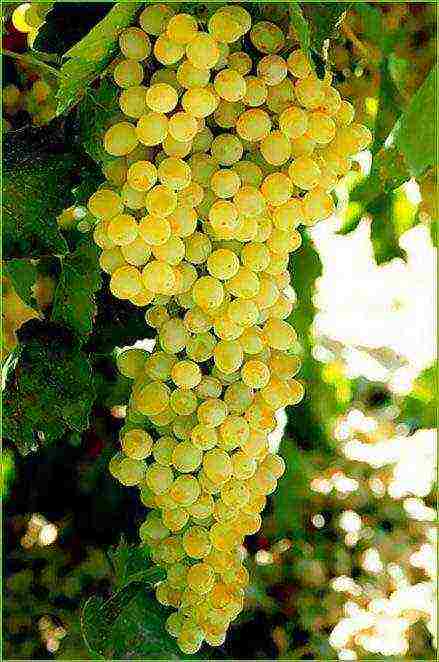
The property of seedlessness depends not only on the variety of grapes, but also on the conditions of its cultivation. Some species are seedless in one region, but degenerate with full seeds in another. So, pink grapes on the Crimean peninsula bear fruit in clusters with seeds inside the berries, and when grown in the Kiev region, seed embryos are not formed.
Of the seedless varieties, “black raisins” and “white raisins” are very popular among buyers, which are used for drying in order to obtain especially tasty raisins. Consider the most common seedless grape varieties - raisins.
Arsenyevsky
The representative belongs to the varieties of amateur selection with an average ripening period of 140 days. The grape flowers are functionally bisexual. The bunches are large, the berries look attractive and appetizing. The average weight of one bunch is 1300-1600 g.
Arsenyevsky is a large seedless grape variety. The berries differ in size and average weight up to 12 g each. "Kishmish Arsenyevsky" belongs to the second class of seedless plants.
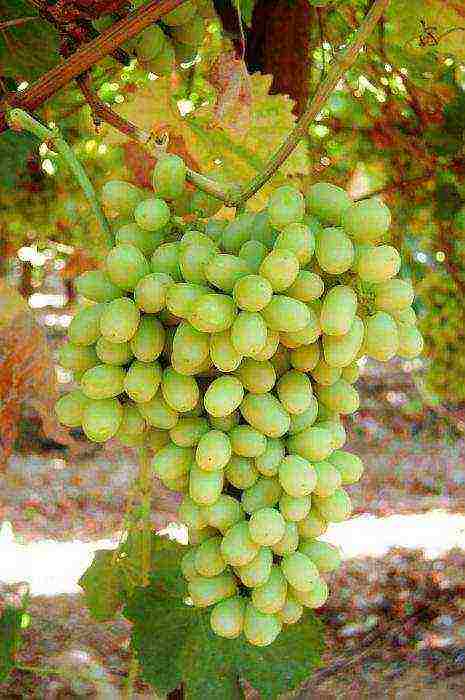
The grape variety is preserved for a long time. After ripening, the bunches can be left on the vine for a long time, without worrying that the berries will lose their taste. The presentation of the grapes does not deteriorate even after long transportation. Wasps practically do not damage the berries, so growing this species is profitable.
The lower permissible temperature level for Arsenyevsky grape bushes is -23 ° C.
"Kesha"
The ripening period of the variety is early, up to 115 days. This variety is seedless, table variety. The berries form clusters of cylindrical-conical shape, but smaller than those of "Arsenyevsky", with an average weight of 300-500 g. The hearths are large, round, like most grape varieties of this group. Each of the berries accounts for 3-4 g, which, after ripening, turn amber with a brownish tint, occasionally yellow-green with a slight waxy bloom. The taste of kesha raisins is notable for its harmony, with moderate sweetness. Under the skin of medium thickness, there is a tasty, juicy pulp with a soft structure.
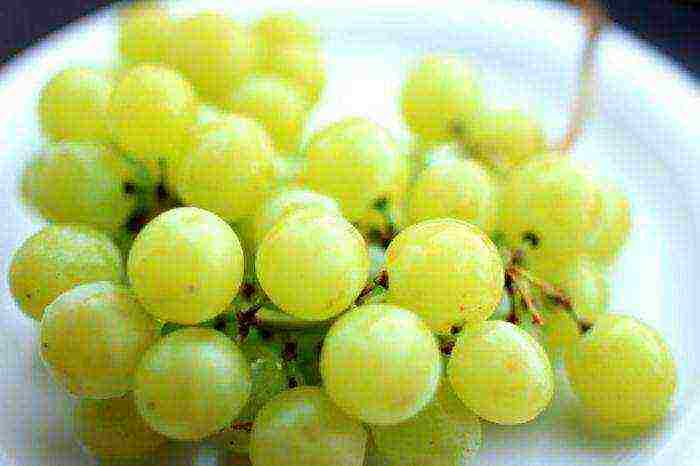
Sometimes, due to the strong density, individual berries fall to the ground, but this phenomenon is rarely observed. "Kesha" is distinguished by its fertility, and from one bush you can get up to 6.5 kg of selected grapes.
"White Flame"
The seedless white grape variety has a very early ripening period - 90-93 days. Berries weigh up to 5 g each, and the total weight of a bunch can reach 2-2.3 kg. After ripening, the grapes acquire a marbled color, filling with a blush.
"White Flame" is distinguished by a combination of rich and soft floral notes. Under the tender crispy skin there is a homogeneous pulp. Grapes are stored for a long time, but during long-term transportation, it is required to carefully pack the bunches in order to protect them from damage. The variety is frost-resistant. Even 20-degree cold does not matter to him.
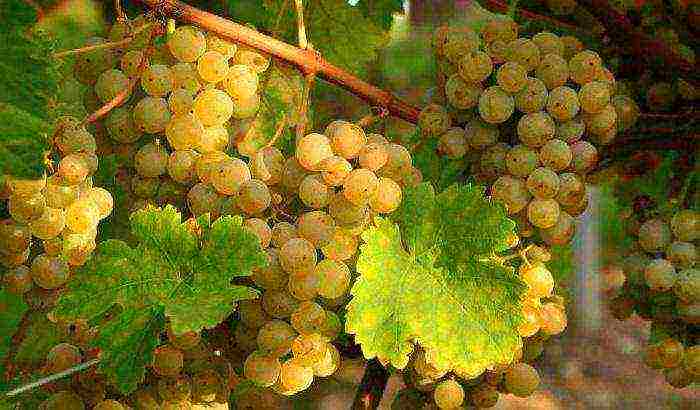
"Radiant"
The variety is high-yielding, with an average ripening period of 130-135 days. The berries are small, oval, slightly elongated, after ripening they reach a weight of up to 2 g, acquiring a pinkish color. The pulp is fleshy and juicy, with a slight nutmeg aftertaste.
Grapes "radiant" - a variety of small grapes without seeds, are classified as high-potential varieties of berries due to the weight of the bunches, the average weight of which reaches 650-800 g. and the formation of bunches weighing 2000 g.
By its taste, the variety is excellent for the production of raisins.
These types are ideal seedless grape varieties for central Russia. The berries are distinguished by good transportability and winter hardiness, therefore they can be grown in places with extreme temperatures. "Radiant" has a long shelf life, therefore it is often found on store shelves.
"Black"
The growing season is 127-133 days. The bushes are vigorous, but not frost-resistant and disease-resistant. Growing such a culture requires careful care of the grapes. This is a variety that is distinguished by its antiquity. They were one of the first to cultivate these grapes. Nevertheless, to this day, it has not lost its popularity.
Black berries with a bluish tint are medium-sized, sweet - contain up to 27% sugar, belong to the 3rd class of seedlessness and are distinguished by high taste. The yield per one hundred square meters is 100-230 kg and is characterized as high.

"Black Sultan"
The growing season is 113-117 days, so one can judge the early ripeness of the grapes. The bushes of this variety are vigorous, and the berries are medium in size. The peculiarity inherent in this species is the transitional class of seedlessness (2-3). The sugar content of the fruits is 17-25%, and the yield is up to 200 kg per hundred square meters.
"Red nutmeg"
The seedless red grape variety belongs to the group of early ripening - up to 115 days. The berries are large in size - up to 7 g, colored red, have a strong nutmeg taste. The average weight of one bunch is 650-850 g. "Red Muscat" is a high-yielding variety with a yield of 5 kg from one bush.
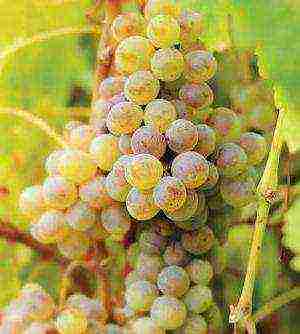
The grapes are highly resistant to frost and disease.
In addition to raisins, the korinka group of grapes is widespread, characterized by a multi-grade. Read on for a brief description of the two most popular grape varieties among consumers.
"Black Cinnamon"
This variety has been known since the times of ancient Greece. Today it is distributed in many countries of the world and is successfully cultivated in Europe. In central Russia, grapes ripen in 122-130 days, forming medium-sized clusters with small berries. Fragrant and juicy pulp is hidden under the thin skin. This variety is characterized by medium disease and frost resistance.
"Russian korinka"
The grapes are very early ripening, winter-hardy, not prone to soreness. During the growing season, forms strong, vigorous bushes with medium-sized clusters, densely covered with large berries. The pulp of the fruit is pleasant to the taste, without the aroma characteristic of grapes. Sugar content up to 21.5%. The yield is high - up to 156 kg per one hundred square meters.
You now know a lot of seedless grape names. Understand the peculiarities inherent in a particular variety, and you can try to distinguish which grapes are on the store shelf and what is better to choose for your goals.
An article on the topic Seedless grape varieties and their choice for our region was written by me for Sadovnik magazine and published in No. 10 in October 2013 under the title "Zest". . The working title of the article is Kishmish, sidlis, cinnamon. Photos from our vineyard and colleagues' vineyards. In the blog, the article is presented in the author's supplemented and expanded version, taking into account the latest data. See links for descriptions of recommended grape varieties. But there are a lot of varieties - even if we consider only the past and not tested - varieties of our collection. Therefore, I apologize for the fact that not all links work yet, but gradually the descriptions of varieties will be supplemented.
Seedless grape varieties are called differently in different countries and regions - toorinka, sidlis, kishmish... This is a special group of grape varieties in which the berries are either completely seedless, or with soft seeds. It is assumed that their origin is ancient. Grapes are by nature a dual domain, there are forms with male and female flowers. The first ones do not form berries, the second ones form berries. At the same time, the berries of wild or natural grapes always have seeds .. But sometime by accident, as it is assumed, in the process of cross-pollination of varieties appeared - and this is very successful for us - the very first form in the history of grapes without seeds-seeds. Perhaps the underdeveloped seeds in grapes are a natural mutation of the variety, which was then fixed by humans by cuttings. This ancestor of kishmish varieties has long been used by people in viticulture for natural and artificial selection. Later, in the ancient era, new forms of grapes appeared with soft seeds, completely imperceptible when eating. At the moment, there are two groups of seedless varieties: cinnamon (with berries without seeds at all), which belong to the ecological-geographical group of the Black Sea basin (convar pontica Negr.), And raisins (with rudiments of seeds in berries), which belong to the eastern ecological -geographic group (convar orientalis subconvar antasiatica Negr). Kishmish also include new seedless varieties of American, Canadian and Israeli selection, which have been named "seedless". Corinka and raisins can be propagated by cuttings and layering, but at the same time, without human intervention, only dioecious varieties survive.
Despite the growing attention to seedless varieties - out of 15 thousand grape varieties, only 150 of them can be called seedless. Most of them are Central Asian varieties, which, in terms of biological characteristics and the amount of required heat intensity, are not suitable for cultivation in the climatic conditions of the center and north-west of Russia, and even more so in its northern regions. Late grape varieties simply do not have time to ripen in the short northern summer.
For planting in the middle lane and to the north, the choice of kishmish varieties should be taken responsibly.It is necessary to choose seedless grape varieties only of an early ripening period. These varieties, with good taste and high sugar content, usually have a smaller berry than varieties with seeds. Nevertheless, there are many summer residents who will never give up, for example, from the small but very tasty Korinka Russian.
I will try to recommend to my fellow northerners a few more seedless grape varieties.
Due to the increasing demand for raisins and seedlings in the world, the breeding centers of our planet are working hard to obtain new early varieties without seeds, but with large and beautiful berries. Grape breeding, including seedless varieties, is the process of crossing between two parent plants with the desired traits. The result of selection is thousands and thousands of seedlings, which undergo careful evaluation and long-term selection in terms of ripening time, aroma, size, color and degree of seedlessness. It usually takes at least 10 years for a variety to be released into production. Seedless varieties are subdivided into 4 categories according to the size of the rudiments. For example, the 1st category of seedlessness - the remnants of seeds are not felt at all, and the 3rd category - the seeds are soft and easy to eat. The degree of seedlessness depends not only on the variety, but also on the flowering conditions, soil and local climate.
The seedless grape varieties that actually grow in our vineyard or on the plots of our northern colleagues are ‘Hungarian Kishmish- 342,’ Rusbol, Korinka Russkaya, Korinka Iskra, Pink Kishmish, Radiant Kishmish, Perlett, etc. Already now, you can pick up for an amateur vineyard and larger seedless varieties - delicious, resistant to frost and fungal diseases. American raisins (seedlings) grow well in our middle lane - ‘Ainset seedlings’, ‘Reeline pink seeds’ ‘,,’ Somerset seedlings, Venus Seedlis.,
The larger-berry Jupiter Sidlis has a dark, fleshy juicy berry with a nutmeg flavor. The bush is medium-sized, shoots with a beautiful scarlet crown. Below is a photo of a flower cluster and a signal cluster of a young Jupiter Sidlis bush in our vineyard. And with you it will grow all the more.
Sidlis tend to ripen early, are resistant, and have good berry quality. Both Rylines pink seedlings and Ainset seedlings ripen perfectly in the suburbs and more northern regions. I strongly recommend to my fellow winegrowers for them - as insurance - to use mainly formations with the accumulation of perennial wood.
Over the last decade, new ultra-large-fruited hybrid varieties have also been developed - Saturn Seedlis, Prime Seedlis, Scarlet Royal, Princess Seedlis, Tomcord, Mystery.
More recently, an interesting and beautiful seedless variety with the romantic name Moon drops (“Drops moon»In translation, or as an option, Tears of the Moon) - see the photo on the left. It's a great black grapes with crispy berries and very high sugar accumulation.
Numerous Japanese seedless varieties are also known - Black Finger, etc.
But it is necessary to get carried away with these large-fruited seedless novelties according to common sense, since their stability is still in the process of research. Therefore, raisins of the latest generation require studying the possibility and characteristics of their cultivation, especially in our and similar regions. But in more southern regions the choice is much larger, so CHOOSE!
Seedless grapes have recently also been considered as a material for juices and wines. In Ukraine, an excellent seedless variety Krasin of early-middle ripening period was bred, which has genetic resistance to biotic (phylloxera, mildew, oidium, gray rot) and abiotic (frost, drought) environmental factors. This variety can be used for food and for winemaking. It was tested by us, but for us, northerners - grape growers, it turned out to be a little late. But, dear colleagues from more southern territories, pay attention to him!
However, mostly seedless grapes are used for eating fresh and dried. In areas where grapes are not a traditional culture, any dried grapes are habitually called raisins. But rightly so - "raisins" are dried stone fruit varieties. In modern Greece, in the city of Piraeus, there is the Raisin Research Institute. It examines the cultivation and processing of seedless and raisin seed varieties separately. Seedless grape varieties in the form of dried berries are called "raisins". Good dried raisins will only come from very sweet grape varieties, otherwise mold may appear during storage. Therefore, the best raisins are those with a sugar content of at least 20% in berries. Sugar is a preservative, not just a sweet taste. But if in our north raisins grape varieties do not pick up the sugar content necessary for drying every year, they are still very tasty and suitable for juice and food.
And gardeners are not so interested in seedless grape varieties because of drying, but because our children love them. And children really love sweet grapes and do not like to bother with seeds, otherwise decide here - to swallow them? And this is said to be bad for the stomach. Or spit it out?) In addition, raisins are excellent pollinators for grapes with female flowers: for example, varieties Talisman, Yadviga, Flora, Zosia, etc. So if you want to please your children and grandchildren and at the same time have a fruitful vineyard, let and small - be sure to plant cinnamon or raisins in it.
Below - with a brief description - are listed some seedless grape varieties, primarily recommended for northern vineyards.
Russian corinka (Russia), the variety is very early, productive, medium-sized, frost resistance -25 gr. C Bunches are medium, winged, berries are white-golden, turning pink on the sunny side, small, tasty, 1 category of seedlessness, Sugar content 22%. Tearing peel. The cultivar is resistant to mildew, but susceptible to powdery mildew. Ripening of shoots is good.
Hungarian kishmish 342
Hungarian kishmish (Hungary] Synonym: GF No. 342 early, vigorous. Frost resistance -26 ° C. Medium clusters. Berries medium and large, green-golden, seedless category 3. Juicy pulp, harmonious taste. Sugar content 21.
The disease resistance of this variety is increased. Harvestable. On large formations, with a large supply of perennial wood, larger clusters are obtained.
Rylines Pink Siddles
Reeline pink sidlis (USA) very early, vigorous, frost-resistant (-27-34). A bunch of 300 g Berries are small, white-pink, pleasant taste with strawberry-pineapple tones. Seedlessness of the 1st category. Sugar content 24%. Formations are recommended: arbor or cordon.
Ainset Pink Seedlis
Ainset Pink Seedlis (USA) Early, vigorous, stable, winter-hardy (-28), Rose berry, pleasant taste, fruit and strawberry, sugar content 23%.
Somerset Siddles
Somerset sidlis breeding Elmer Swenson, USA) Very early, medium-sized, frost-resistant (-34 ° С) Small clusters. The berries are small, bright pink, as if glowing in the sun with exquisite fruity notes, rudiments are rare. Possibly the best seedless variety for northern viticulture.
Venus Sidlis.
Venus (USA) early, vigorous, stable, frost-resistant (-28 ° C. Medium bunches, Medium berries, blue. Harmonious taste, with a light strawberry-nutmeg aroma. Sugar 20% Seedlessness category I. Good rooting of cuttings. High yield
Best regards, Olena Nepomniachtchi.


